|
|
Ramses II Obelisk (Poznań Archaeological Museum)
| Present Site: | Poznań Archaeological Museum, Poznań, Poland N 52°24'26.8"(52.407445) E 16°56'04.3"(16.934517) |
| Pharaoh: | Ramses II (New Kingdom 19th Dynasty, Reigned 13 Century BC) |
| Measurement: | 3.00 meters high without the pyramidion |
| Weight: | Approximately 1.8 tons |
| Stone: | Grey granite (granodiorite) |
About The Site:
Poznań is one of the oldest towns in Poland, located in west-central Poland. Poznań Archaeological Museum (Muzeum Archeologiczne w Poznaniu) is a very small museum with a history dating back to the 19th century. Museum is constituted by a exhibition corner for the excavated goods in Poland, and for Egypt and Nubia. In spite of a small museum, the authentic Egyptian obelisk is exhibited here. But this is a loan from Egyptian Museum in Berlin which is known as a collection of Nefertiti Bust, etc. Since 2002, the long-term loans have been made to this Museum, so it has been rented for already 14 years.
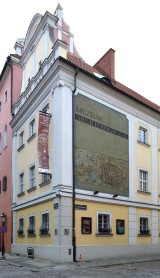
|
Behind of this loan, there would be a long-time friendship between professors Dietrich Wildung (the director of the Ägyptisches Museum und Papyrussammlung in Berlin) and Lech Krzyżaniak (the director of the Poznań Archaeological Museum), who were cooperating in research of Egypt and Sudan, and the loan was probably decided with the discussed by these two persons. In the website of this Museum, the process of the installation work of the obelisk is posted.
The place where the obelisk currently stands looks like the "hall", but here would be originally a "courtyard" because there are the windows on surrounding walls, and it is to be considered that the ceiling is attached later, and it was renovated to the room (or a "hall").
Although this is a small size Museum, but the Museum's website on the Obelisk is well prepared, this is probably because the archaeologist who has been working the excavations in Egypt for a long-time, is working for this Museum. Particularly the descriptions on the obelisks, such as about the small obelisks erected in front of tombs in Old Kingdom Era, and the large obelisk for the Sun Temple in Abusir (located in Nile Delta), etc. are very detailed and excellent. So I would recommend you to visit here for learning the obelisks general by all means.
How To Get There:
Poznań is a city with 550,000 population, but the old city where is the sightseeing spot is very limited. City's central place is Old Market Square (Stary Rynek), surrounding the Town Hall (Ratusz Poznański) . There are many café and restaurants in the Square, and it's always busy with tourists. Most visitors to Poznań would come here.
The Poznań Archaeological Museum (Muzeum Archeologiczne w Poznaniu) is near to the south-east corner of the Square. When you enter the narrow road down to the south along the shops that lined the east side of the square, you can immediately see the yellow building with the sign and the drawing of "MUZEUM ARCHEOLOGICZNE" on the wall (See photo above left). This is the Museum. Due to the small building, many people may want to doubt, "Is this really a museum?", but you would notice the Archaeological Museum posters and exhibits if you see carefully.
When I visited here, I got here the building without a problem, but I could not understand where is the entrance, as there was only an entrance for the parking lot. So I doubted "Is this really a Museum?", "Mueseum is closed today?". After walking around the perimeter of the building, then I finally found the closed door on the next red building, which was not locked and I could go enter inside if I pushed the door (See photo right below). I think this is very rare case of the Museum that the entrance door is on another building and is closed.
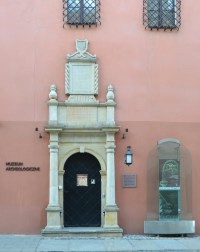
|
About The Obelisk:
The top of this obelisk is missing, and added the existing golden pyramidion when this is installed here in this Museum. The 3 meters is the measurement figure without pyramidion.
According to the description by the Museum, this obelisk was initially erected as a pair, in front of Temple of god Khenti-kheti in the city of Hut-heri-ib (Greek Athribis, present Tell Atrib) in the Nile Delta. Athribis was once the capital of the 10th Lower Egyptian nome [subnational administrative division of ancient Egypt], near to present-day Benha, about 50 km north of Cairo.
Another one of pair is currently kept in the Egyptian Museum in Cairo, the Museum's website says. However, this is not publicly exhibited in the Cairo Museum. The pedestals of two obelisks including obelisk themselves are registered in the Museum (JE 72147), but no description on another obelisk was found.
This obelisk was discovered when it was used as a threshold in a house in Cairo in the 19th century. The pyramidion was lost and the inscriptions on one side was damaged when it was re-used as a threshold. After its discovery, it was brought to Europe in 1895 by Carl Reinhardt, a German Consul. Since 1896 it has been in the possession of the Berlin Museum.
On this obelisk, the names of three pharaohs of New Kingdom 19th Dynasty; Ramses II, Merneptah, Seti II (or Sethi II). The description by the Museum says: Inscription of the four sides are constituted almost same, but different in details. I will explain as the side, Museum's description panel is placed is the front side, for convenience.
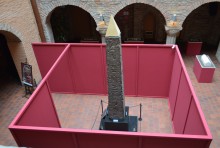
|
In the center column, Ramses II's horus name, coronation name, and birth name are inscribed. According to the Museum's description, firstly, the name of Ramses II is engraved incised (or dented). Therefore the Museum estimates that the Pharaoh's name was re-engraved over on previous another Pharaoh's name, for example Amenhotep III. Next, Merenptah, the son and successor of Ramses II, added his names at the bottom of the obelisk. And upper part spaces were subsequently filled in with the king name of Seti II. Also Museum's description says; the parts representing the god Seth in the king name of Seti II were destroyed in later times. The reason is, the god Seth was increasingly considered as the enemy against the god Osiris in the late period, and the god Seth was becoming to be considered as the patron of neighbor foreign nations that were invading into Egypt.
The inscriptions at the middle of left side surface are abraded away. This would be because people walked on this part when it was uses as a threshold in a house in Cairo. The inscriptions on other three side surfaces are well preserved, because it's engraved deeply. We feel an unique impression from this black stone obelisk which is filled inscriptions chock.
Notes For Pictures:
With unknown reason, this obelisk was surrounded by the wood panels when I visited here in April 2016. I was surprised and really disappointed when I faced this sad looks, and involuntarily murmured "What's this !?" Because of this situation, I was hardly taking a picture of this obelisk. One lucky thing, the obelisk can be looked down from the window of the upper floor. So, I got a permission from the Museum staff for taking pictures. The back side picture is taken from left diagonally backward.
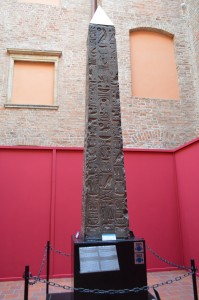 Front |
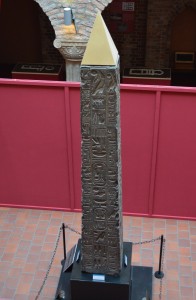 Right Side |
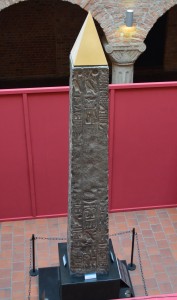 Left Side |
Back and Left Side |
|||
April 23, 2016 by Hiroyuki Nagase (For high definition image, please click the picture) | ||||||
Copyright Hiroyuki Nagase nagase@obelisks.org and Shoji Okamoto okamoto@obelisks.org